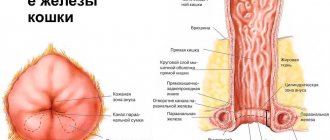Animals in particular cats are not as sensitive to temperature changes as people, thanks to their fluffy and thick coat. Many pets that their owners let out for walks ask to go outside in any weather, and a cold frosty winter is no exception. But, if in the warm season the owners do not worry about the health of their furry pets, then in the bitter cold they are a little afraid to let them outside.
Are there any grounds for such fears and what sub-zero temperatures can cats withstand without freezing or frostbiting their paws or ears?
Winter for walking cats
Everything is clear with street cats - they take care of their own salvation in the harsh winter. Their favorite places are basements with warm pipes, attics, and entrances. During this period, they especially need human support!
For domestic cats living in the yard or walking outside, the best recipe for safely surviving the cold is... being in the owner’s warm home. It's very simple - at sub-zero temperatures it is better not to let the cat out of the house!
Some owners leave their cats outside the house, thinking that they are adapted to life outdoors. Unfortunately, this can put the animal at risk of serious illness.
What temperature is acceptable for a cat to stay in the cold?
temperature is -20° C. Weather conditions also play an important role - strong winds and high humidity aggravate the frost. Of course, each animal has its own limit depending on its health, age, coat condition, nutrition, fat layer, immunity in general, etc. There are cats that can withstand 30-degree frosts, while for others -5°-10 is enough. ° to get serious problems.
Caring for a cat in winter
You can determine that a cat is cold by several signs. The animal begins to tremble, its paws become cold and the pet pulls them under itself. The animal persistently climbs into the warmest place.
At low temperatures, the animal’s joints become especially sensitive, and older cats are the ones who suffer the most from this.
Therefore, it is important to make it easier for your pet to move around, which involves jumping or jumping, to help move from a height to the floor or from the floor to a sofa by installing special stairs and ramps.
If your pet has long hair, then it is better to take care of it more carefully, avoiding the formation of tangles.
If the coat is not rich, clothing specially made for pets will help out. There are even “warm mats” of different types of action:
- electric with continuous current supply;
- heated when the contact is closed from the weight of the animal lying on the rug;
- heated in microwave ovens.
Accessories, tools and methods
If the above methods do not help protect your cat from the heat, you may want to try additional methods. The cat will feel better if its physical activity is reduced as much as possible, so bowls, a tray and a bed should be placed in the same room.
Once you're sure your cat is completely healthy, you can use homemade ice cream as an extreme coolant. Naturally, the product is contraindicated for cats with lactose intolerance and should not contain sugar. Ice cream is fed to the cat from a teaspoon in a slightly melted state.
Many owners decide to cut their cat's hair to ease its suffering. Grooming as a method is not prohibited, but as mentioned above, a pet cannot be cut to zero. The more important point is combing. By summer, the cat's undercoat (if any) is completely shed and must be thoroughly combed out. The higher the air temperature becomes, the coarser the pet's fur will become and this is normal. In the process of increasing the stiffness of the guard hair, the cat may lose a small part of the old hair, this is also normal.
Even if your pet doesn't like water, place a small bathtub freely accessible. Cats are not afraid of water, but they do not get into it unless necessary. Increased air temperature is the most natural need to wet the wool known in nature.
Modern industry keeps pace with progress. Today, in almost any large store, you can purchase cooling accessories for animals. For dogs, the range is wider; suits and paw muffs are sold. For cats, the range is currently limited only to cooling bedding and collars. The accessories are filled with hydrogel, which not only holds water, but also maintains a low temperature. Before use, the accessory is placed in a container of water for the time specified in the instructions. Typically, cooling accessories maintain a cooling effect for 1-3 days and last 2-4 years.
Behavior of cats in winter
Most cat owners notice that with the onset of the first cold weather, their pets behave completely differently than in the warm season. Even the most playful and active animals turn into lazy couch potatoes who spend most of their time on the sofa or near a warm radiator.
It should also be noted that all felines have an increased appetite in winter, as a result of which the pets noticeably gain weight, gaining a few extra pounds. Cats do this on a subconscious level, because their genetic memory tells them that a layer of subcutaneous fat helps them survive in winter frosts.
Some owners are worried about this and begin to limit the cat's food, fearing that the pet's excessive appetite can lead to obesity. But such fears are completely in vain, because with the onset of spring, the animal’s need for an additional portion of food will disappear, and the pet’s weight will return to normal.
Are there freezing cats?
The owners of such pets confidently answer – yes! Of course, pampered animals who only look outside from the window and then with longing, dreaming of the summer sun, freeze more often. In addition, some breeds are naturally thermophilic, especially if their origin is associated with warm regions. Such cats will huddle close to heating devices and ask for a blanket, even when there is no question of cold. Owners of such pets note that in winter their pets sleep more and move much less.
Another factor influencing the “freezing” of cats is their age. Kittens tolerate low temperatures less well due to imperfect thermoregulation mechanisms. A similar phenomenon is observed in elderly animals - their body, alas, no longer works “like a clock.”
In addition, unhealthy cats begin to freeze faster - those suffering from a disease, recovering from an illness or surgery, having a weak immune system or being very thin and lacking body fat.
What is hypothermia?
Hypothermia is a severe pathological condition that is caused by a decrease in the cat’s body temperature below the minimum acceptable level. Note that the normal body temperature of a healthy adult cat varies from 38 to 39°C. In kittens, this indicator ranges from 38.5 to 39.5°C, with short-term jumps up to 40°C being acceptable. This is due to the imperfection of their thermoregulation center, which has not yet had time to “tune in.”
The main physiological mechanism that is triggered when an animal or person is cold is involuntary muscle contraction (shivering). Since the body of cats is covered with fur (although not in all breeds), they suffer less from the cold than humans, but still they are very far from the animals of the Arctic.
The maximum risk of developing hypothermia is created in conditions when it is not only cold outside, but also humid. If the animal's fur is moisturized, there is no air gap between the hairs, resulting in the cat being “naked.” In this condition, your pet is especially susceptible to developing hypothermia. What other categories of animals are most likely to develop this pathological condition?
These are the oldest cats and small kittens. Due to age (excessively large or small), their thermoregulation system malfunctions and cannot maintain a stable body temperature. That is why “oldies” and small kittens should always be kept in comfortable conditions. It is generally not advisable to let old cats outside in winter and autumn.
How does winter affect outdoor cats?
For homeless cats in winter, the only philosophy that is relevant is that saving drowning people is the work of the drowning people themselves.
Each of them survives as best they can. They prefer places on heating mains, in warm basements, attics, etc. Unfortunately, many of them do not survive severe frosts. If a cat lives in the owner's house, but is used to walking outside, it is better not to let it go for a walk on frosty days. And you definitely shouldn’t leave your cat in the yard until you return when you leave home. The domestic cat is not a polar bear, so don't be under the illusion that it can survive in arctic conditions.
Remember that the survival threshold for a cat is considered to be an outside temperature of at least -20 degrees. True, there are animals that can withstand thirty degrees of frost, and there are sissies that cannot stand even five degrees. If strong winds and high humidity are added to the frost, then it is generally better for a domestic cat to stay indoors.
Other useful tips
A pet that eats high-quality, balanced food will survive sub-zero temperatures much easier. When cold weather sets in, energy costs for heating increase
Therefore, it is recommended to pay attention to the diet, especially for kittens and older cats. In winter, it is necessary to increase the calorie content of the menu, add complete proteins and fats
These substances are found in sufficient quantities in meat and dairy products.
Homeless animals rarely eat healthy food, so it is natural that not all will survive in the cold and severe frosts. Therefore, if abandoned cats live in the yard or nearby, you should try to help them cope with bad weather. You can feed the strays with leftover food or give them inexpensive dry food. Particularly compassionate cat lovers make them a primitive shelter where the animal can hide from snow, wind and severe frost. But if the cat is cold and all the signs of hypothermia are visible, you should not leave it to suffer outside, because the body will not stand it. A rescued animal can become a new member of the family and find caring and loving owners.
Winter Cat Houses: Creating the Perfect Shelter for Cats
Some people may ask whether a cat can survive winter outside. This is a reasonable question, but the answer depends on how cold the outside temperature is. If the temperature drops below freezing, your cat is unlikely to be able to spend much time outside.
Snow leopards and other wild cats grow coats designed to withstand cold temperatures. Unfortunately, many indoor cats do not have the same opportunity.
Some cats can go outside in the winter as they find the air temperature where they feel comfortable. Unfortunately, winter weather can change from day to day. The temperature may suddenly drop while the cat is outside, and you may not be there to let her in.
In this case, a winter shelter for cats can be very convenient. You can find these at pet stores, but you can also make them yourself. Winter cat shelters can be as simple as an insulated box with a small flap on the front to allow cats to get in and out.
They will keep your cat's body warm, at least until you get home. More advanced models may include a heating pad, but this will require a suitable electrical supply and can be harmful to the environment if left on all the time.
These winter shelters for cats can not only help them outdoors, but can also be beneficial for feral and stray cats. In winter, their resources will be even more strained. A shelter can help keep a stray cat safe on a harsh winter day.
Diet
Cats naturally lose their appetite in hot weather, which is not a concern for you or your family. The pet does not need to be persuaded to eat, much less force-fed. At high temperatures, a cat can remain absolutely hungry for about a day, a kitten for no more than 12 hours. Naturally, your task is to make sure that the cat drinks enough water and visually looks healthy.
Meal times should be moved to earlier in the morning or late evening. It is advisable, during extremely high temperatures, to switch the cat to a single meal and feed the pet in the evening. At night, when the air temperature drops, the cat needs energy to stay warm. During the day, it will be difficult for the patient to cope not only with the heat, but also with digesting food.
With a natural diet, all heavy foods should be excluded from the diet, and the amount of grains should be kept to a minimum. Beef, pork (if you give it to a cat), lamb should be replaced with rabbit, chicken or quail meat. Remove food from the bowl as soon as the cat is satisfied, because in the heat, it will take several hours for the food to disappear and there is a risk of poisoning.
Do cats need outdoor walks?
Here the division no longer depends on the personal qualities and preferences of the animal, but on the living conditions. As a rule, cats living in the private sector walk all year round. Typically, such pets are equipped with an undercoat and can feel good even in cold weather. Only the owners should provide unimpeded access to the home so that Vaska or Masha, who has been having a good time, does not freeze while trying unsuccessfully to enter the house.
But cats that are not allowed out or are not eager to be “freed” themselves can freeze in the cold. There are frequent cases of pets freezing into ice, frostbite of limbs, ears and tails and other tragic situations. Most often this happens when an unadapted pet ends up on the street - of his own free will or not, and cannot return home.
Cats do well without street walks, and if they have such a desire, you can always use a harness and take out the four-legged reveler. Usually, two or three walks in the cold are enough for homebody pets to cool down their ardor, and they calmly wait for the warmth, looking out of the window.
As you can see, cats are not “walruses” at all, and they will not “harden” unless they find themselves in harsh conditions. Of course, these animals, like all others, are more resilient and strong than humans, but their heat-loving nature is very pronounced. Therefore, if a cat freezes while walking, then most likely she does not need such stressful situations. It’s worth postponing walks until spring!
The woolen outfit and natural endurance are reassuring, but looking at your pet meowing under the door, you can’t help but think: “Do cats freeze in winter? Isn’t Vaska’s passion for running through freshly fallen snow dangerous?” You can understand whether a cat is cold only by observation, because our pets differ from each other not only in eye color and taste preferences. How do cats cope with the cold and how can you tell if the ambient temperature is not making the furry explorer happy?
Although why furry? There are also hairless cats, smooth, completely devoid of hair. It is clear that such a cat freezes at sub-zero temperatures, quickly releasing the accumulated heat. Letting a sphinx go for a walk in sub-zero temperatures is an unthinkable idea, the consequences of which can be very disastrous. If your pet is accustomed to walking or if a naked cat is cold even in an apartment, you can put sweaters and overalls on it. Of course, the fabric warms worse than a real fur coat, so walks should not be long: your paws are shaking, your ears are cold - go home and warm up. At what temperature does a naked cat freeze? As a rule, sphinxes experience discomfort even at +10°C, not to mention sub-zero temperatures.
But let's get back to the cats sporting luxurious fur coats. The coat can be long or short, but if it is two-layered, with a well-developed undercoat, are cats cold in winter? The undercoat retains heat well and prevents overheating, keeping body temperature within normal limits. However, such protection is not endless: just as a person dressed in a doha, earflaps and felt boots will still freeze after a few hours spent on a frosty street, so a cat, “wrapped” in the best fur, will sooner or later begin to freeze. At what temperature do fluffy cats freeze depends not only on the thermometer readings, but also on the actions of the pet, air humidity and other nuances. “Dry” frost is easier to bear; with low activity you freeze faster; increased humidity means you feel the cold more clearly. Everything is like in humans, with an adjustment for cat endurance.
Cats without undercoat freeze faster than Siberians, Coons and representatives of other “furry” breeds. Cold air penetrates the skin faster, heat leaves faster. These cats have cold paws and ears even after short walks at -15 Celsius. But a Siberian, not pampered by life in the arms of a radiator, can walk for a couple of hours without danger to health, even at -30°C.
How to help a frozen animal?
If your four-legged pet is very cold, you need to start normalizing its body temperature as quickly as possible. In some cases, the slightest delay can cost the animal its life. The actions of the owner of a frozen pet are as follows:
- Wrap the cat in a warm blanket or terry towel. To warm it up faster, you must first hold the blanket on the radiator.
- Place your four-legged pet wrapped in a blanket on a bed near the radiator. Other sources of heat would be useful - heating pads, bottles of hot water, which should be placed around the four-legged frostbite.
- Close all windows and doors in the room in which the frozen animal is located. There should be no drafts in it.
- Dry your pet's fur with a hairdryer if it gets wet in the rain or snow.
- Stay close to the cat until it warms up.
- Feed the warmed animal warm, preferably liquid food.
What you should not do in this situation is try to warm your four-legged pet in hot water. Water procedures in this state are strictly contraindicated for him. He will only freeze even more and may get a serious cold.
In case of severe frostbite, veterinary attention is required. A frostbitten four-legged patient will be prescribed IVs with warm solutions, warm pleural lavage, the use of a ventilator to normalize body temperature, and the use of analgesic veterinary medications that relieve pain while restoring tissue sensitivity. Subsequently, a comprehensive examination of the pet will be required to assess the condition of the internal organs.
Frostbite
The cat's paw pads, tail and ear tips are most sensitive to low temperatures.
Superficial frostbite affects only the skin and subcutaneous tissues, which initially turn pale. As blood circulation is restored, the skin turns red, swells and peels. More severe frostbite causes blisters with clear or milky fluid. Frostbitten areas are bordered by a clear line of demarcation from living tissue.
We suggest you read: What to do if a cat scratches its neck until it bleeds
Deep frostbite is characterized by death of the skin, subcutaneous tissue and muscles. In especially severe cases, tendons and bones may be affected, and tissue rejection to a great depth may be observed. First, blisters containing blood form, which turn into black scabs within two weeks. Deep frostbite leads to complete necrosis (death) and tissue loss.
If sensitivity and normal skin color remain in the affected area, and if pressure is applied to it, a hole remains, the prognosis is favorable. If the skin feels wooden to the touch, has bluish lesions and blisters with blood, and there is no trace left on it after pressure, tissue necrosis is possible.
What to do? The affected area should not be rubbed, especially with snow, so as not to damage the tissue further and cause infection. You can quickly warm the affected area by soaking it in warm (not hot!) water or constantly applying a warm, damp towel to it and lightly massaging (without rubbing) until the tissues become red. Then carefully dry and apply a loose bandage. For further treatment, it is better to contact a veterinarian.
For superficial frostbite, you can use the “Rescuer” balm, protecting the affected area from licking (for example, using a protective collar).
https://www.youtube.com/watch?v=xmtC6M29Zxs
Blisters with clear fluid are opened and an anti-prostaglandin drug (such as aloe vera juice) is applied. Hemorrhagic (blood mixed) blisters are not touched. The animal is prescribed non-steroidal anti-inflammatory drugs, drugs to improve blood circulation, and antibiotics to prevent infection. Dead tissue is removed surgically.
Winter for domestic cats
Behavior
As sunlight decreases, cat activity also decreases.
“Move less, eat and sleep more”
is their slogan for this time of year. Four-legged pets become calmer and lazier, preferring a secluded warm corner to games. With the arrival of winter, the ratings for warm blankets, shelves in the linen closet, radiators and heaters rise. To reduce heat loss, the cat curls up into a ball, wrapping itself in its fluffy tail.
Physiology
Nutrition.
One of the means to combat the coming cold is the accumulation of subcutaneous fat. Cats begin to eat more, but move less. And therefore, a caring owner must find a middle ground between natural requirements and reasonable necessity. After all, a four-legged couch potato hardly needs a thick layer of fat that protects from frost. So are the problems associated with obesity.
Wool.
Usually in the fall, cats actively shed in order to acquire high-quality wool with a thick undercoat for winter. But the human “heating season” blurs the molting picture, prolonging it... sometimes until the next molting. Therefore, your furry pet needs careful care for its coat - regular brushing, paste to remove hairballs from the stomach, and possibly the use of special vitamins (for example, Felvit N, Brewers Yeast) - about this.
Diseases.
With the onset of cold, dampness and drafts, domestic cats' immunity decreases. And they can become prey to colds (upper respiratory tract infections), cystitis (inflammation of the bladder) - the fault is cold window sills and floors. And if you accidentally “forget” your pet on the balcony, the consequences can be more serious, including hypothermia and frostbite. Therefore, it is worth being vigilant - do not let your pet lie or sit in cold and drafty places (or insulate them, making them safe for health) and postpone walks on the balcony until better times. Well, strengthen your immune system with multivitamins, especially with a natural diet. During this period, fresh green grass from the pet store will not be superfluous.
At what temperature can cats live outside: which breeds cannot tolerate cold
Animals, in particular cats, are not as sensitive to temperature changes as people, thanks to their fluffy and thick fur coat.
Many pets that their owners let out for walks ask to go outside in any weather, and a cold frosty winter is no exception.
But, if in the warm season the owners do not worry about the health of their furry pets, then in the bitter cold they are a little afraid to let them outside.
Are there any grounds for such fears and what sub-zero temperatures can cats withstand without freezing or frostbiting their paws or ears?
How cats prepare for cold weather
Cats are not as sensitive to temperature changes as humans, thanks to their fluffy and thick fur coat.
It’s no secret that cats gain several kilograms of excess weight during the winter. In this case, owners do not need to sound the alarm and put their pet on a strict diet.
In this way, the animal prepares itself for winter, and does this on a subconscious level, thanks to genetic memory, when cats still walked on their own and were forced to take care of themselves.
All cats gain several kilograms of excess weight during the winter.
The fur of these creatures also becomes a little thicker and longer in winter and, remarkably, cats practically do not shed in winter.
Another interesting fact is that cats rarely bathe in winter, and this is due to the fact that wet fur is unable to protect them from the cold.
At what temperature can a cat walk outside?
Cats are one of the hardiest animals, and these creatures live on almost all continents, so most of them are perfectly adapted to cold climates.
Most cats tolerate cold climates well.
A cat can safely walk outside, even if the thermometer shows ten to fifteen degrees below zero.
Thick wool and dense undercoat perfectly protect animals from cold and frost and thanks to them the cat almost does not freeze.
Extremely negative temperatures
But don't think that a cat can survive in extreme subzero temperatures. If she stays in the cold for a long time at minus twenty degrees, then this can end disastrously for her: the animal will freeze its paw pads and ears, which are almost devoid of fur.
Most experts claim that cats can survive at temperatures as low as minus thirty-five degrees, but this is not true.
A cat cannot survive in extremely low temperatures!
Unfortunately, not all cats are lucky enough to have a home and loving owners. Homeless animals are forced to survive in the winter, taking refuge in hallways, basements or abandoned houses.
What to do if your cat is cold
If the pet is too carried away by a walk in severe frost, then in order to save the cat from hypothermia, it should be immediately wrapped in a warm terry towel.
If your cat is cold, you need to wrap it in a warm towel.
As a rule, a cold cat will instinctively look for the warmest place in the house, for example, near a radiator or electric fireplace. Many animals can crawl under a warm blanket or blanket.
What you should absolutely not do in this case is bathe your pet. A hot bath will not only not help, but will also cause your pet to freeze even more after it and may even catch a severe cold.
What cat breeds can't stand the cold?
Oriental cat breeds are extremely heat-loving and will not go outside in the cold.
It is clear that such fluffy cats as Siberian, Maine Coons or Norwegian Forest cats, thanks to their luxurious fur coat, can stay outside for a long time in winter.
But eastern breeds, for example, Abyssinians, Persians or Burmese cats, are extremely heat-loving and for them even five degrees below zero is a good reason not to leave the house.
At what temperature do hairless cats die?
There can be no question of releasing hairless cats in winter! Such exotic pets as “sphinxes” or “bambinos” get very cold and if the animal is outside at sub-zero temperatures, it will certainly die.
Hairless cats should not be allowed outside in winter!
Cold is also poorly tolerated by small kittens, elderly animals, pregnant cats or those suffering from any disease. It is strictly forbidden to let them outside in winter.
In winter, you should be especially careful about your pet and it is advisable to walk him on a leash. After all, if a cat gets lost and cannot find its way home, then it is likely that in severe frost it may die from hypothermia.
Signs of freezing
The presence of a thick undercoat helps to retain heat even regardless of the length of the coat. A Siberian cat or coon can calmly walk for two hours at a temperature close to 30 degrees below zero. It is important here that the pet can return home at any time.
IMPORTANT! Mats in long-haired cats interfere with heat exchange.
Shorthaired and Oriental cats begin to freeze earlier, especially if the owner does not often pamper them with walks in the fresh air. They can be insulated by wearing overalls or a blanket.
Some cat breeds have a thick undercoat, but do not shed seasonally, but throughout the year. The human factor is the beginning of the heating season. For example, you can let Scottish cats outside in winter only after first checking the thickness of their fur coat.
During seasonal or non-seasonal shedding, regularly comb the animal's fur to prevent it from ingesting its own hair. Walking in frosty air has a positive effect on the condition of the coat and undercoat.
Endurance to frost is also influenced by the general state of health: old or pregnant cats, teenage kittens, and a sick animal will freeze faster. Their immunity is weakened, so it is advisable to postpone walking even in light frost.
It is enough for the pet to move a lot in the apartment on frosty days, and not sleep all the time. A sedentary lifestyle can affect his health . Get him interested in a new toy, play with him, provoke him into active actions.
While walking, you need to carefully observe the animal. If your pet is active and the air humidity is low, then you can take a longer walk.
Cats get cold when their paw pads and ears freeze. As soon as the paws begin to tremble, the fur fits tightly to the body - the cat is cold, it’s time to go home to warm up.
Cats that have the habit of freely walking outside begin to ask to go home or look for a warm shelter. Long walks in cold air can cause inflammation of the upper respiratory tract and cystitis in your pet.
ATTENTION! You can tell that a cat is freezing by its cold paws, which it presses tightly to itself.
For safety in extreme temperatures, it is better to walk your pet on a leash or under unobtrusive supervision.
There are breeds of cats for which walking is contraindicated even with low positive thermometer readings. Of its own accord, a heat-loving cat will not even try to go outside.
Such exotic creatures as the hairless sphinx or the short-legged bambino simply cannot survive outside in winter, even for a short period of time. The skin of hairless cats is hot to the touch, but is unable to retain heat. They simply freeze in a cool room, especially with a draft.
Comfortable temperature for hairless cats starts from +15 degrees. During a walk, they will be glad to have a warm jacket or overalls.
Heat-loving eastern breeds - Abyssinians, Burmese, Persians - consider frost of five degrees a valid reason for refusing to leave the house. Sometimes they are carried outside for a walk in their arms.
Video about how a cat was rescued in severe frost
Of course it's freezing! It is absurd to think that since a cat is originally a wild animal, it can easily and easily adapt to frost and winter cold. Even the super woolly indoor cat needs the warmth of the hearth in winter.
Observing our pets, we come to the conclusion that even at room temperature, cats find a place where it is warmer - and it is there that they curl up and rest. What can we say about frosts?
What temperature can cats withstand in winter?
The answer to this question cannot be universal for all Muroks and Murzikovs. Some experts do not recommend walking at -20°C. But this is a very relative parameter. Because there are a lot of factors that affect the “winter hardiness” of each individual animal.
Breed. It’s easier for mongrels, but for sphinxes, for example, it will be cold even at +10°C.
Wool, presence or absence of undercoat.
Habit. There are representatives who walk around their property in any weather, especially in the villages, few people bother with cats and cats. But our village man managed to get a slight frostbite in his ear - and it’s simply impossible to keep him in the house. And there weren’t even any significant frosts...
Age. Kittens and old animals cannot keep their body temperature constant.
General health. Hidden diseases, pregnancy in cats weakens the animal and its resistance to low temperatures decreases.
Cats and cats in the snow in winter - photo story
The woolen outfit and natural endurance are reassuring, but looking at your pet meowing under the door, you can’t help but think: “Do cats freeze in winter? Isn’t Vaska’s passion for running through freshly fallen snow dangerous?” You can understand whether a cat is cold only by observation, because our pets differ from each other not only in eye color and taste preferences. How do cats cope with the cold and how can you tell if the ambient temperature is not making the furry explorer happy?
Although why furry? There are also hairless cats, smooth, completely devoid of hair. It is clear that such a cat freezes at sub-zero temperatures, quickly releasing the accumulated heat. Letting a sphinx go for a walk in sub-zero temperatures is an unthinkable idea, the consequences of which can be very disastrous. If your pet is accustomed to walking or if a naked cat is cold even in an apartment, you can put sweaters and overalls on it. Of course, the fabric warms worse than a real fur coat, so walks should not be long: your paws are shaking, your ears are cold - go home and warm up. At what temperature does a naked cat freeze? As a rule, sphinxes experience discomfort even at +10°C, not to mention sub-zero temperatures.
But let's get back to the cats sporting luxurious fur coats. The coat can be long or short, but if it is two-layered, with a well-developed undercoat, are cats cold in winter? The undercoat retains heat well and prevents overheating, keeping body temperature within normal limits. However, such protection is not endless: just as a person dressed in a doha, earflaps and felt boots will still freeze after a few hours spent on a frosty street, so a cat, “wrapped” in the best fur, will sooner or later begin to freeze. At what temperature do fluffy cats freeze depends not only on the thermometer readings, but also on the actions of the pet, air humidity and other nuances. “Dry” frost is easier to bear; with low activity you freeze faster; increased humidity means you feel the cold more clearly. Everything is like in humans, with an adjustment for cat endurance.
Cats without undercoat freeze faster than Siberians, Coons and representatives of other “furry” breeds. Cold air penetrates the skin faster, heat leaves faster. These cats have cold paws and ears even after short walks at -15 Celsius. But a Siberian, not pampered by life in the arms of a radiator, can walk for a couple of hours without danger to health, even at -30°C.
Helping your pet with hypothermia
Many cats love to walk in winter, play with snow and catch snowflakes. Sometimes the pet gets too carried away with the walk and when he comes home he is shaking all over from the cold. What should the owner do in this case, and how to help the pet warm up faster?
?
- First of all, the animal must be wrapped in a thick towel or warm blanket;
- A frozen cat will try to warm up near a radiator or fireplace, so you should place its house or bedding near them;
- It is necessary to ensure that there are no drafts in the house, as the pet may catch a cold;
- You can dry your cat's wet fur with a hairdryer;
- Bathing in warm water will not warm the cat, but will cause it to freeze even more, so bathing the animal is extremely undesirable.











